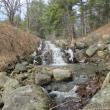Hiking the Bass Falls Preserve in Alna
It was 50 degrees when we recently explored the Bass Falls Preserve in Alna. This mostly wooded property lies along the upper waters of the Sheepscot River.
The Sheepscot Valley Conservation Association acquired this property in 1997. The Bass Falls Preserve is located off Route 218. In January, SVCA merged with Damariscotta Lake Watershed Association, Hidden Valley Nature Center and Sheepscot Wellspring Land Alliance to become Midcoast Conservancy.
To visit the Bass Falls Preserve from the Wiscasset Post Office on Main Street in Wiscasset, drive 7.2 miles north on Federal Street (Route 218). It’s a pleasant ride; along the way you’ll pass the historic Alna Central School built in 1795 that sits on a small hill, followed by the cemetery and the yellow 1789 Alna Meeting House. Just ahead on the right is the preserve’s parking area that’s marked with a wooden kiosk.
No trail maps were available when I visited, although a map of the preserve was posted which you can download by visiting the SVCA website. There were several dog leashes hanging in the kiosk for pet owners to borrow. Dogs are welcome but their owners need to have their pets under control at all times. SVCA asks that dogs be leashed May through July when birds are nesting.
There’s one main trail leading into and out of the preserve. It carries you gradually downhill through a meadow alongside seven nesting boxes placed there to attract eastern bluebirds. You’ll need to return in the summer to catch sight of one.
As you might expect the path was muddy in a few places but overall in good condition. It leads to a tote road where a carved sign points to the trail that veers off on the left. This is the “white” trail and serves as the main path into and out of the preserve. It carries you through a forest of towering northern pines to the river.
There were just a few icy spots and patches of snow in the woods. Small trail bridges spanned most of the mucky places that have frozen and thawed several times during what’s been an unnaturally mild winter.
Hiking in these mud season-like conditions, it’s best to wear a comfortable hiking boot with a heavy lugged sole to avoid slipping. The terrain here is fairly hilly. If you’ve invested in leather boots be sure they’ve been thoroughly waterproofed with an all-natural leather dressing. Snow-seal or L .L. Bean Boot Guard are good products because they contain beeswax, lanolin and natural oils that both waterproof and protect the leather. A walking stick will come in handy and always remember to carry a compass, GPS and/or cell phone.
The white trail eventually divides, splitting off into the “blue” trail on the right and further on the “red” trail on the left. Both are blazed at regular intervals with paint on the trees. Staying on the main trail brings you to a rustic fishing cabin overlooking the river.
According to the SVCA brochure, Stephen June and his uncle Clifton Walker carried the cabin to the property in 1965. The two men used it as a fishing camp. In the years since, the trees have all grown up blocking whatever view their once was from the cabin porch. The riverbank is fairly steep here with a strong current, the water being brownish from heavy rains that fell earlier in the week.
From the cabin, follow the red trail north, through a small gully where it soon intersects with the “turquoise” trail. Bearing to the right carries you along the river shore where you’ll discover some calmer waters and nice places for picture-taking.
Bald eagles and ospreys have been spotted nesting in this area but none were seen during my visits on Friday morning and Sunday afternoon. Ducks certainly seem to enjoy this part of the river. I saw four mallards, a drake and three hens swimming here and further along caught sight of five hooded mergansers that took flight when they heard my approaching footsteps.
The turquoise trail, .9 mile in length, loops around through the “Beaver Gate” (two trees felled by beavers) and up a small knoll to the cellar hole. Judging by the foundation stones, it must have been a sizable building that once stood here. Twisted pieces of rusted iron, broken bricks and odd bits of molted glass are scattered about.
Wandering a short distance north of here carries you across an earthen dike to where a small waterfall spills from a pond. Returning to the turquoise trail, it runs through a glade and then continues sharply uphill. It eventually loops back to the place where it intersected with the red trail, which carries you to the cabin and the main trail back to the kiosk.
Not long ago a reader asked me to include the degree of difficulty for the hiking trails I write about. I’d call this one “moderate.” If you plan to do the entire Bass Falls trail system in one visit be prepared for a fair amount of up and down walking. The longest part for me on both of my visits was the final leg when I was trudging uphill through the meadow to the parking area.
Along with hiking, the property is open to both hunting and fishing. Visitors are welcome to enjoy the Bass Falls Preserve from dawn to dusk. Fires are prohibited. As always respect Mother Nature and leave no trace behind.
SVCA, formed in 1969, currently protects over 3,000 acres through purchases and conservation easements.
Event Date
Address
United States
























